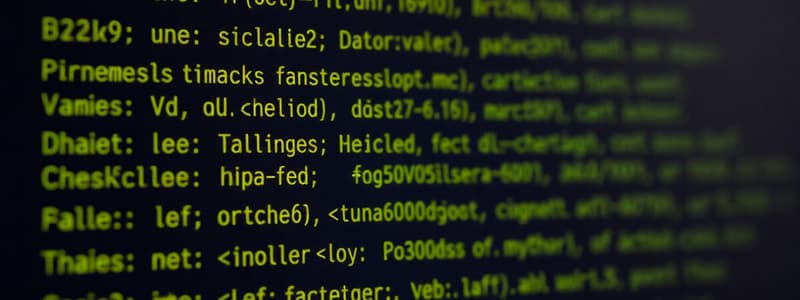Podcast
Questions and Answers
What is the purpose of a variable in Python?
What is the purpose of a variable in Python?
- To create loops
- To store data values (correct)
- To write functions
- To analyze data types
Which of these is NOT a built-in data type in Python?
Which of these is NOT a built-in data type in Python?
- List
- Tuple
- Binary Tree (correct)
- String
What will be the output of the following code: 'if 5 > 3: print("True")'?
What will be the output of the following code: 'if 5 > 3: print("True")'?
- Nothing
- False
- True (correct)
- Error
What is the main purpose of a loop in Python?
What is the main purpose of a loop in Python?
Which statement is true about functions in Python?
Which statement is true about functions in Python?
Flashcards
What is a string in Python?
What is a string in Python?
A Python variable that stores a sequence of characters, like letters, numbers, or symbols, enclosed within quotes. For example, "Hello World" is a string.
Data Types in Python
Data Types in Python
In Python, data types define the kind of information a variable can store, such as numbers, text, or truth values. Examples are integers, floats, and strings.
What is an if statement?
What is an if statement?
A conditional statement that executes a block of code only when a specific condition is true. It helps make decisions in your program based on whether something is true or false.
What do loops do in Python?
What do loops do in Python?
Signup and view all the flashcards
What are functions for?
What are functions for?
Signup and view all the flashcards
Study Notes
Introduction to Python
- Python is a high-level, general-purpose programming language known for its readability and versatility.
- It uses indentation to define code blocks instead of curly braces, making code visually organized.
- Python's extensive libraries facilitate diverse applications including web development, data science, and machine learning.
Variables
- Variables are used to store data in a program.
- Variable names should start with a letter or underscore and can contain letters, numbers, and underscores. (e.g.,
myVariable,_count,variable1). - Variable assignment uses the
=operator. (e.g.,x = 10). - Variables can hold different data types, and type checking is dynamic.
Data Types
- Integers: Whole numbers (e.g.,
10,-5). - Floating-point numbers: Numbers with decimal points (e.g.,
3.14,-2.5). - Strings: Sequences of characters enclosed in single or double quotes (e.g.,
"hello",'world'). - Booleans: Represent truth values (True or False).
- Lists: Ordered sequences of items, mutable (can be changed). (e.g.,
[1, 2, 3]). - Tuples: Ordered sequences of items, immutable (cannot be changed). (e.g.,
(1, 2, 3)). - Dictionaries: Key-value pairs, mutable (e.g.,
{'name': 'Alice', 'age': 30}).
if Condition
ifstatements execute a block of code only if a condition is true.elif(else if) allows for multiple conditions to be checked.elsehandles the case where none of the previous conditions are true.- Comparison operators include
==(equal to),!=(not equal to),>(greater than),<(less than),>=(greater than or equal to),<=(less than or equal to). - Logical operators include
and,or,not.
Loops
forloops: Iterate over a sequence (e.g., a list, tuple, string) or a range of numbers.whileloops: Execute a block of code repeatedly as long as a condition is true.breakstatements can exit a loop prematurely.continuestatements skip the rest of the current iteration and proceed to the next.
Functions
- Functions are reusable blocks of code.
- They are defined using the
defkeyword followed by the function name and parentheses. - Arguments are input values passed to the function.
- Return statements can send output values from a function.
- Functions help organize code and make it more modular.
- Docstrings are used to document the purpose and arguments of functions, improving code readability.
Studying That Suits You
Use AI to generate personalized quizzes and flashcards to suit your learning preferences.
Description
This quiz covers the basics of Python programming, including how to use variables and understand different data types. It is designed for beginners to build a strong foundation in Python, which is known for its readability and versatility in various applications such as web development and data science.




